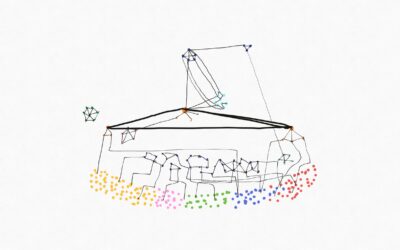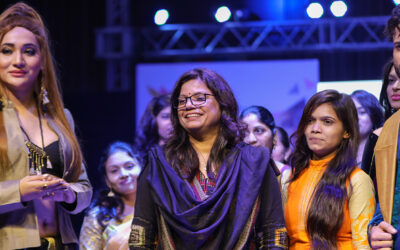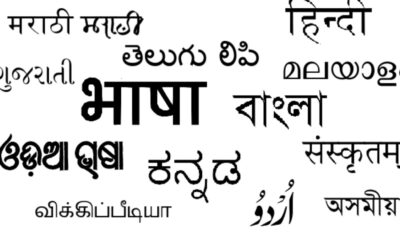The floor, the once-blue drums, tables and chairs; are all covered in a white-ish powder. Anything you touch and you will dust your hands. Machines that you don’t recognize, lie around you. There are big pots made with plaster of paris filled with a grey-looking clay sitting in groups. Racks across the room are covered to the brim with beautiful products, pieces that were a part of multiple experiments, and reminders of everything this man has worked upon. I was at the studio of Ramju bhai, a Kumbhar (earthen pot maker) who lives in Bhuj.
His studio is a breezy space opening up to a road on the front and his backyard on the other side. A third door opens up to a courtyard in the centre of his two-room house. I was here to speak to him not just about pottery but also the stories, songs, sayings and learning that they pass on from one potter to another. These insights would help me introduce children in the middle school to work with clay.
During the conversation, Ramju bhai mentions that this work of pottery is “our heritage, our virasat“‘. Just when I could finish asking him to elaborate on this statement, he corrected himself, saying, “It is not just my heritage, it is everyone’s heritage.”
A statement that I thought I understood then but the meaning dawned upon me a few months later.
My name is Daraab Saleem Abbasi. I am an India Fellow from 2022 cohort, working in Kachchh, Gujarat with Khamir, a crafts based organization. If you look up ‘crafts of Kachchh’ online, you will be come across a vast sea of information. The rich diversity of tradition, culture, skill and craftsmanship attracts many students, professionals and visitors to this land. I have a background in Visual Communication design. Kachchh has, today, become a place that a design student is likely to find himself in, as a part of their documentation projects, graduation assignments or internships. The rich textile based crafts or the various products designed and made here, attract creative professionals from all over the country. For me, however, it was none of that.
I came to Kachchh with little knowledge about the place, let alone the crafts practiced here. I only knew that they exist. My work at Khamir began with exploring the various locations we work in. Slowly, I became a part of the Craft Curriculum project. Here, we are constantly trying to understand what is ‘crafts’ and figuring out how we could take it to children in schools. This has helped me spend a lot of time in the practice of certain activities like spinning and working with clay as well as meeting craftspersons to speak to them about their life and work.
I have always associated crafts with craftsmanship or the ability to work with fine details and display immense skill of working with hands. The ability to produce something beautiful and exquisite. Even at my house, craft products are displayed with pride, accompanying stories about where they are from and how they are made.
At Khamir, a word I often hear, is ‘revival’. The revival, preservation and sustenance of craft practices and craft based livelihoods comes up in a lot of conversations with colleagues, community members and guests. But what does it mean to revive something?

To restore to life or consciousness. When we speak of reviving any particular craft, we need to know what this craft is. Let’s take an example of ‘Ajrakh’. What comes to your mind when you hear ‘Ajrakh’? Is it something like this?

When I think of crafts, it is often easy for me to remember them through their visual identities. To think of them as products and commodities. They have been objects of trade for several years. However, there was a time when the exchange wasn’t done for money or with money. When I looked beyond their visual identities and form, I understood the processes and traditional practices. Going back to Ajrakh, the craft has largely been reduced to motifs being printed using screen as well as digital prints.
Understanding the process of crafts also helps us understand how changing times, technologies and economies have played a role in how artisans work. The introduction of and dependence on chemical colour dyeing is one such practice that has seen a multitude of change. This makes me think about the processes once used earlier, and why they were what they were. It also helps me connect the practices with people’s ecological understanding and values, as a person, as a craftsperson and a professional.
I’m trying to dig deeper to place crafts in a system of exchange, interaction and interdependence between communities. It has always been tied with a user. To fulfill needs and demands of people. Once that is done, does anyone bother about the forms in which a craft’s practices have existed. What is the heritage of a craftsperson? What is the relationship between people who make these products and those who use them.
“It is not just my heritage, it is everyone’s heritage”. For as long as crafts persons have made products, people have used them. Potters fulfill the needs and requirement of their villages. Weavers do the same and so does the leather artisan. When I purchase a matka to store water in my house, is it not a part of my life as much as the potter’s? Does the potter not become a part of my life too? And pottery?
I have always looked at crafts as an outsider, as a consumer. But to understand it, I need to get inside. They can mean different things to different people, our relationship with material, with utility, how they reach us and what happens when we choose something else.
Revival of crafts means ‘n’ number of things to work with. From how something looks to who makes it; how something gets made and how it reaches me and you. It is a reflection of identities, visual and social. Systems of trade and systems of consumption. It asks us to look at products, processes, materials, systems, structures, relationships, history and heritage. All of our heritage!
Featured image by Annabelle, a fellow from 2020 cohort.




0 Comments